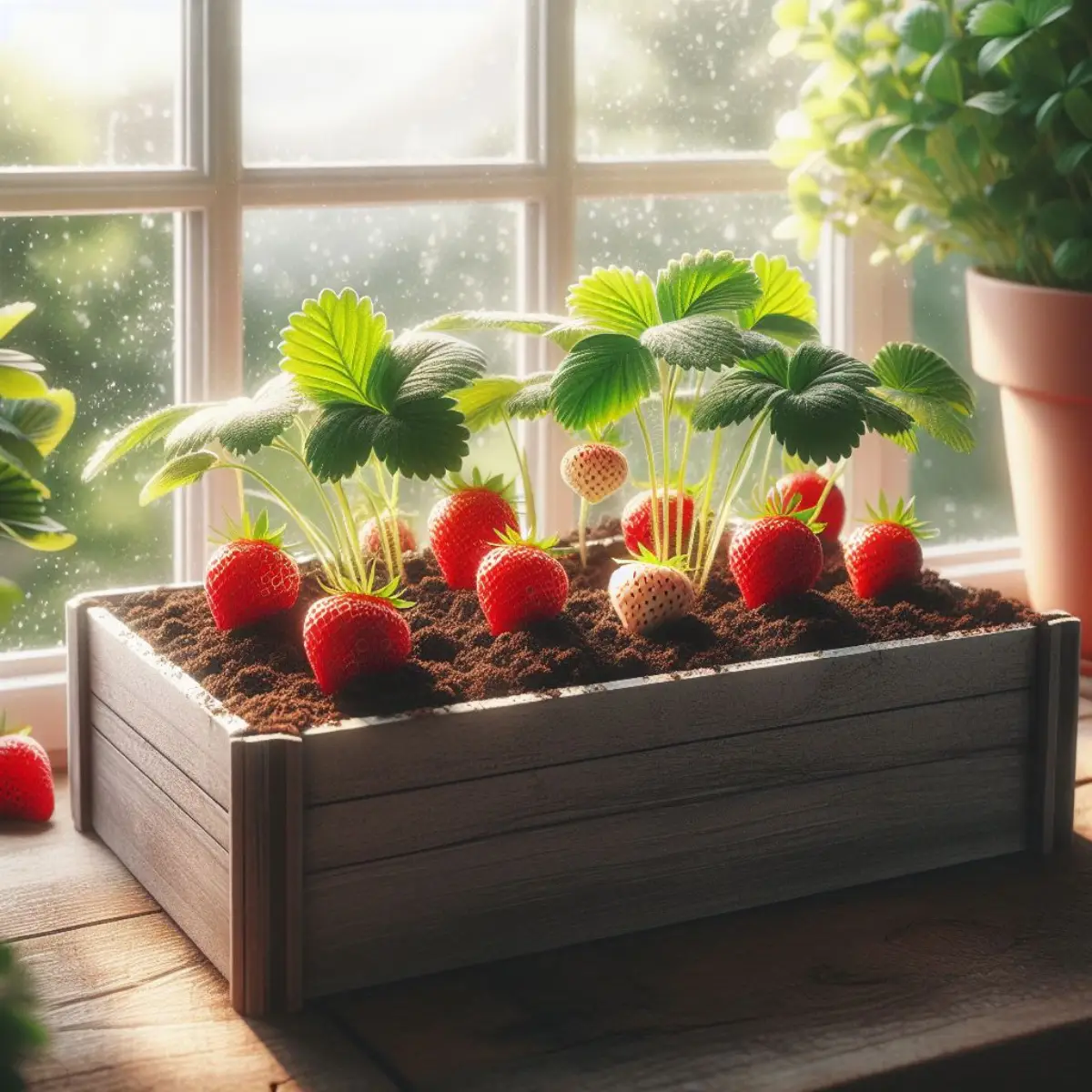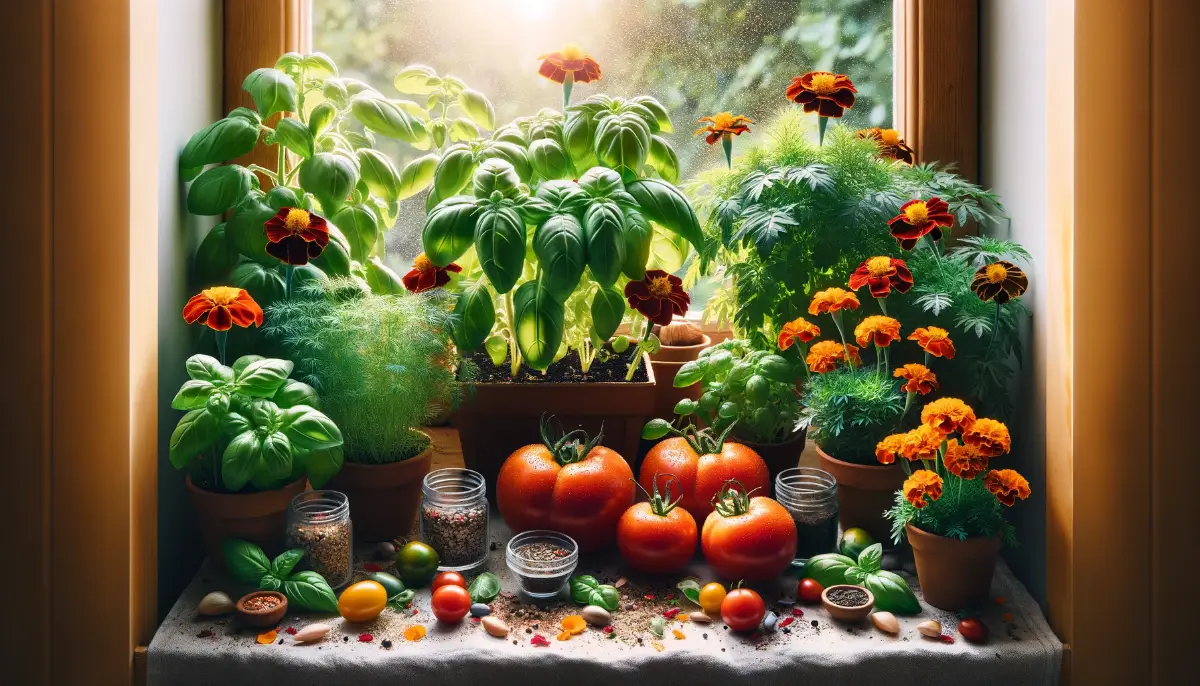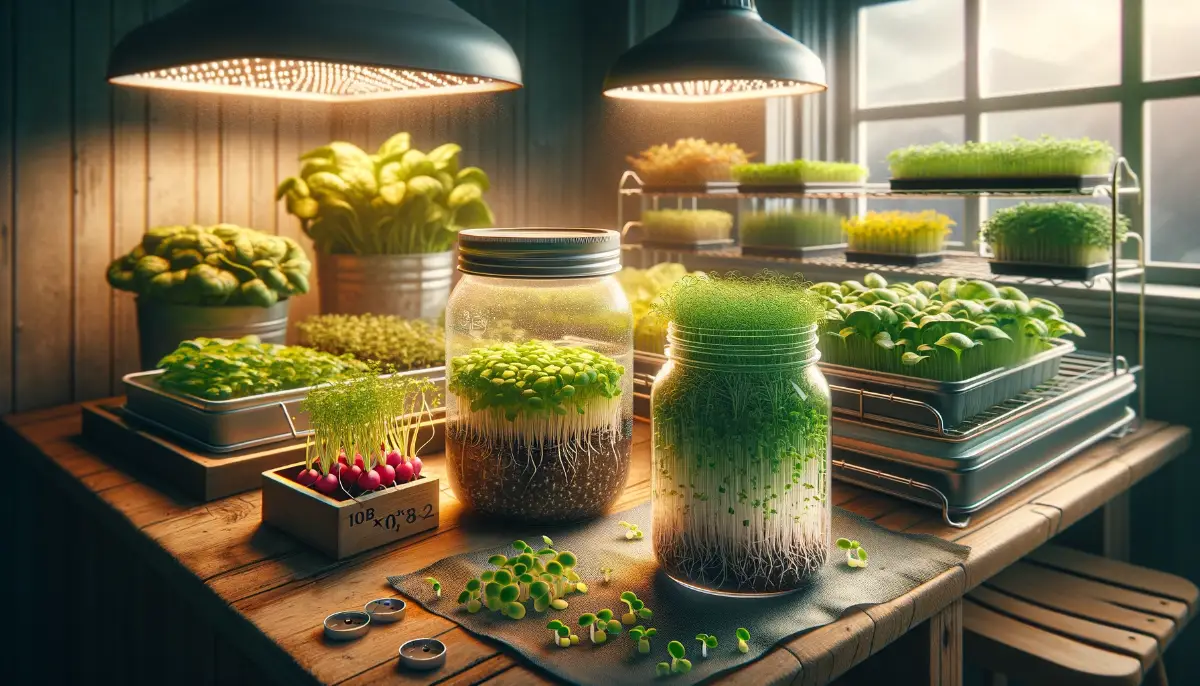Growing strawberries indoors has become a popular way for gardeners to enjoy this sweet and nutritious fruit all year round, regardless of outdoor weather conditions. This comprehensive guide will walk you through the essential steps and considerations for cultivating strawberries within your home, ensuring a bountiful harvest.
Tips for Growing Strawberries Indoors
Growing strawberries indoors isn’t just a hobby; it’s a practical solution for fresh produce enthusiasts looking for year-round availability. Indoor cultivation allows for control over the environment, ensuring optimal growth conditions and protection from outdoor pests and diseases.
Whether you have a spacious greenhouse or a small sunny spot in your living room, growing strawberries indoors can be a rewarding endeavor.
- Selecting suitable strawberry varieties for indoor growth.
- Understanding light, temperature, soil, and container requirements.
- Advanced care techniques including fertilization and pest management.
- Utilizing hydroponics for more efficient growth.
- Tips for harvesting and enjoying your strawberries.
Essential Requirements for Indoor Strawberries
Selecting the Right Varieties
Not all strawberries are created equal, especially when it comes to indoor gardening. For success, it’s crucial to select the right varieties. Day-neutral strawberries like ‘Albion’ and ‘Seascape’ are often recommended for indoor cultivation due to their continuous fruiting ability throughout the growing season.
These varieties do not depend on day length to produce fruit, making them an ideal choice for the controlled environment of indoor gardening.
Soil and Planting Medium
The foundation of healthy strawberry plants starts with the right soil mix. A blend of coconut coir, peat moss, and perlite has been found to be effective. This combination helps to maintain the right balance of moisture and air while keeping the pH level between 5.5 and 6.5, which is ideal for strawberries.
The coconut coir acts as an excellent absorbent for nutrients, providing a slow release to the plants, while peat moss helps in balancing the pH.
Container Selection
Choosing the appropriate container is another critical step. Strawberries have a relatively shallow root system, so the container doesn’t need to be very deep but should have good drainage to prevent waterlogging. Rectangular containers are great for windowsills, maximizing space and sunlight exposure.
Hanging baskets are another option, especially for limited spaces, as they allow for vertical growth. Regardless of the type, ensure the container allows for at least 5 inches of soil depth to accommodate the roots comfortably.
Preparing the Planting Area
Once you have your containers and soil ready, it’s time to prepare the planting area. If you’re using seeds, remember that they might require a period of cold stratification (freezing) to simulate winter conditions before planting.
This process helps to break dormancy and encourage germination. When planting, ensure the seeds or seedlings are spaced adequately to avoid overcrowding, which can lead to mold and disease.
Light, Temperature, and Initial Watering
Strawberries require at least 6 hours of direct sunlight daily. If natural light is insufficient, supplement with LED grow lights. Use LED grow lights to supplement natural light if necessary, ensuring a PPFD (Photosynthetic Photon Flux Density) of 500 μmol/m²/s for optimal growth.
Keep the indoor temperature between 60°F (16°C) to 80°F(26°C) for optimal growth. After planting, water the soil to make it evenly moist but not soggy, setting the stage for healthy growth.
Keep the soil consistently moist but not waterlogged. Overhead watering should be done carefully to avoid burying the crown of the plant under the soil. Use filtered water to avoid chemical buildup that could affect plant health.
Advanced Care
Incorporating organic options into the care of indoor strawberries is a great way to support sustainable gardening practices while ensuring your plants thrive. Here are some organic approaches to nutrient management, pest control, and overall plant health:
Organic Nutrient Management
- Compost Tea: An excellent organic fertilizer, compost tea provides a broad spectrum of nutrients and beneficial microbes that help improve soil health and plant growth. It can be applied directly to the soil or used as a foliar spray to support leaf health and resistance to diseases.
- Seaweed Extracts: Seaweed or kelp extracts are rich in micronutrients and natural growth hormones that can boost plant health and productivity. They are particularly beneficial in promoting strong root development and enhancing fruit quality.
- Fish Emulsion: This is a fast-acting organic fertilizer that provides a good nitrogen source. It’s especially useful during the vegetative growth stage of your strawberries to promote leafy growth. However, it should be used sparingly, as its strong odor can attract pests.
- Worm Castings: Worm castings are another excellent organic amendment that slowly releases nutrients into the soil. They also improve soil structure, which helps with water retention and root aeration.
Organic Pest and Disease Control
- Neem Oil: A natural pesticide, neem oil is effective against a wide range of pests and fungal diseases. It works by disrupting the life cycle of pests and is safe for beneficial insects, making it an ideal choice for organic gardening.
- Diatomaceous Earth: This is a non-toxic powder made from the fossilized remains of algae. It can be sprinkled around the base of plants to deter pests like aphids and slugs.
- Beneficial Insects: Introducing beneficial insects, such as ladybugs and lacewings, can help control pest populations naturally. These predators feed on common pests that affect strawberries, like aphids and mites.
Soil Health and Plant Support
- Mulching: Applying an organic mulch layer around your strawberry plants can help retain moisture, suppress weeds, and gradually improve soil health as it decomposes. Straw, pine needles, and leaf litter are all good organic mulch options.
- Crop Rotation and Companion Planting: If you’re growing multiple plants indoors, rotating your strawberries with other crops can help prevent the buildup of soil-borne diseases. Companion planting with herbs like basil or chives can also deter pests naturally.
Pollination
Indoor strawberry plants, like their outdoor counterparts, require pollination to produce fruit. However, without the natural presence of pollinators like bees and wind, indoor plants often need a helping hand. Here’s how you can ensure your indoor strawberries are properly pollinated:
Manual Pollination Techniques
Using a Brush or Cotton Swab: Gently brush or dab the center of each flower with a small paintbrush or cotton swab. This process transfers pollen from the male parts of the flower (stamens) to the female part (pistil), mimicking the action of natural pollinators. You should move from flower to flower, ensuring that pollen is distributed evenly among the plants.
Finger Pollination: Similarly, you can use your finger to lightly touch the center of each flower, transferring pollen from one to another. This method is simple and effective, especially if you don’t have a brush or cotton swab handy.
Environmental Adjustments
Air Circulation: Enhancing air movement around your strawberry plants can also aid in pollination. A gentle breeze from a fan set on a low setting can mimic the wind, helping to distribute pollen among flowers. Just make sure not to set the fan too high, as strong winds can damage plants or dry out the soil too quickly.
Timing and Frequency
- Best Time for Pollination: Strawberry flowers are typically ready for pollination a few days after they open. The flowers’ stigmas (the top part of the pistil) are most receptive during this time.
- Frequency: To ensure effective pollination, visit each plant to pollinate every 2-3 days while the plants are flowering. This regular attention helps mimic the ongoing activity of natural pollinators and increases the chances of fruit set.
After Pollination
Monitoring: After successful pollination, the flowers will begin to wither, and small green strawberries will start to form. It’s essential to continue providing optimal care—proper watering, lighting, and nutrient management—to support fruit development.
Troubleshooting Common Problems
Growing strawberries indoors can sometimes lead to challenges that may affect the health and productivity of your plants. Here are some common problems you might encounter, along with solutions to help you troubleshoot:
Poor or No Fruit Production
Causes:
- Inadequate light can lead to poor flowering and fruit set. Strawberries need at least 6 hours of direct sunlight or equivalent artificial light.
- Improper pollination since indoor environments lack natural pollinators.
Solutions:
- Ensure your plants receive enough light, supplementing with LED grow lights if necessary.
- Manually pollinate flowers using a small brush or cotton swab.
Yellowing Leaves
Causes:
- Overwatering or poor drainage leading to root rot.
- Nutrient deficiencies, particularly nitrogen.
Solutions:
- Adjust your watering schedule to allow the soil to dry out slightly between waterings.
- Improve drainage by ensuring containers have adequate holes and using a well-draining soil mix.
- Test soil and adjust fertilization as needed to address nutrient deficiencies.
Pests and Diseases
Common Pests: Spider mites, aphids, and whiteflies can infest indoor strawberries.
Common Diseases: Powdery mildew and root rot are frequent issues.
Solutions:
- Regularly inspect plants for signs of pests or disease.
- Use neem oil or insecticidal soap to manage pests. Ensure good air circulation and reduce humidity to prevent fungal diseases.
- Remove and dispose of infected plants or plant parts to prevent the spread.
Leggy Growth or Weak Plants
Causes: Insufficient light is a common reason for leggy plants as they stretch towards the light source.
Solutions:
- Move plants to a brighter location or provide more artificial lighting.
- Rotate plants regularly to ensure even light exposure.
Flowering Without Fruit
Causes: The absence of pollinators in indoor environments can result in flowers not setting fruit.
Solutions:Manually pollinate your strawberry plants to encourage fruit development .
Browning of Leaf Edges
Causes:
- Over-fertilization can cause salt buildup in the soil, leading to leaf burn.
- Low humidity or high temperatures can also contribute.
Solutions:
- Flush the soil with water to remove excess salts.
- Monitor and adjust fertilizer application according to plant needs.
- Increase humidity around plants if the air is too dry.
By keeping a close eye on your indoor strawberry plants and addressing problems promptly, you can enjoy a healthy and productive indoor garden. Regular care, including proper watering, lighting, and fertilization, will help prevent many common issues and ensure a bountiful harvest of delicious strawberries.
FAQs on Growing Strawberries Indoors
Can I grow any variety of strawberries indoors?
Not all strawberry varieties are equally suited for indoor cultivation. Day-neutral and everbearing varieties are often recommended indoors because they produce fruit throughout the year under the right conditions. June-bearing varieties, while possible to grow indoors, have a more limited harvest period.
How much light do indoor strawberries need?
Strawberries require at least 6 hours of direct sunlight per day, but for indoor conditions, 12 hours of artificial light provided by LED grow lights can adequately substitute for natural sunlight. This ensures they receive enough light to grow and produce fruit.
What’s the ideal temperature for growing strawberries indoors?
The optimal temperature range for growing strawberries indoors is between 60-80°F (15-27°C). Temperatures outside this range can inhibit growth or fruit production.
How often should I water my indoor strawberry plants?
Water your strawberry plants to keep the soil moist but not waterlogged. Check the soil daily, and water it when the top inch feels dry to the touch. Avoid overwatering to prevent root rot.
Do indoor strawberries need pollination?
Yes, strawberries need to be pollinated to produce fruit. In an indoor setting, this may require hand pollination since natural pollinators are not present. You can use a small paintbrush to transfer pollen from one flower to another.
Can strawberries be grown hydroponically indoors?
Yes, strawberries can thrive in a hydroponic system indoors. Hydroponics can offer efficient water and nutrient usage, faster growth rates, and potentially higher yields compared to traditional soil-based growing methods.
What common pests and diseases should I watch out for?
Indoor strawberries can be susceptible to pests like spider mites, aphids, and fungal diseases like powdery mildew. Regularly inspect your plants for signs of pests or disease and take action promptly to mitigate any issues.
How do I know when to harvest strawberries?
Harvest strawberries when they are fully red, have a sweet aroma, and are firm to the touch. The best time to pick them is in the morning when they are still cool.
Can I use regular potting soil for my indoor strawberries?
Yes, you can use regular potting soil, but it’s beneficial to choose or mix a well-draining medium. Adding perlite or vermiculite can improve drainage and aeration, promoting healthier root development.
How can I increase fruit production in my indoor strawberry plants?
Ensure your plants receive enough light, maintain optimal temperature and humidity levels, fertilize appropriately, and regularly prune old leaves and runners to focus the plant’s energy on fruit production.










